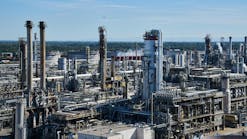The Norwegian Petroleum Directorate has warned Phillips Petroleum Co. Norway AS it will shut down giant Ekofisk oil field over safety concerns before winter 1995-96.
On Oct. 8 NPD gave Greater Ekofisk licensees 3 weeks to state their case.
Later that day Phillips, operator of the Ekofisk complex in the Norwegian North Sea, said the threat was intended to speed changes in the field's processing and transportation systems.
NPD cited studies carried out by Phillips that revealed aging equipment and inadequate maintenance. Seabed subsidence, which led to several of the field's platforms being jacked up 3 m in 1987, made things worse.
TANK PROBLEM
The central processing and storage tank in Ekofisk Center, in Block 2/4, is the problem. It receives oil and gas from Ekofisk field, as well as Cod, Edda, Eldfisk, West Ekofisk, Albuskjell, and Tor fields, all owned by the Ekofisk licensees and operated by Phillips. It also handles production from Ula, Gyda, Valhall, and Hod fields.
The tank was installed in 1973 as the focal point of the 10 platform Ekofisk complex. As much as 600,000 b/d of oil passes through Ekofisk Center for transport to Teesside, U.K. More than 2 bcfd of gas is sent to Emden, Germany.
When the Ekofisk steel platforms were jacked up in 1987, to lift them back above the 100 year wave height, it was deemed impossible to raise the concrete tank. So a concrete barrier was placed around it. This was built in two halves and mated on site in 1989.
NPD cited a "continued negative development" in the condition of the tank, concluding that further modifications will not prevent deterioration. It said continued operations beyond winter 1995-96 "will not provide a sufficient level of safety for personnel, the environment, and the economic assets."
NPD said it will monitor further developments on the tank to help maintain safety levels until permanent shutdown takes place.
PHILLIPS DEFENSE
Phillips defended the tank, criticizing NPD's decision to announce the possible closure through the media, rather than directly.
"We are convinced the Ekofisk complex is operated in the safest manner possible," said John Whitmire, Phillips' senior vice-president, exploration and production.
"It is our belief that the real issue is the NPD's desire to expedite changes in the existing processing and transportation system at the complex - changes that are presently being studied by the Phillips Norway group.
"We feel construction of the tank barrier will provide a sufficient margin of safety to protect our people and our equipment."
Phillips did not comment on its plans to upgrade Ekofisk pending the outcome of talks with NPD. The company recently let a contract for planning to jack up two more Ekofisk platforms in 1994 (OGJ, Sept. 21, p. 47).
UNDER THREAT
Closure of Ekofisk field would mean a loss of more than 250,000 b/d of oil to licensees of the seven Ekofisk group fields, besides gas production.
Working interest owners are Phillips 36.96%, Norsk Fina AS 30%, Norsk Agip AS 13.04%, Elf Aquitaine Norge AS 7.594%, Norsk Hydro Producksjon AS 6.7%, Total Norge AS 3.547%, Den norske stats oljeselskap AS 1%, Eurafrep Norge AS 0.456%, Coparex Norge As 0.399%, and Norminol AS 0.304%.
Phillips' Greater Ekofisk net production is 72,000 b/d of oil and 318 MMcfd of gas. That amounts to about one fourth of the company's worldwide liquids and gas production. The Greater Ekofisk group's net flow is 214,000 b/d.
Other operators using Ekofisk facilities would lose out, too. BP Petroleum Development of Norway AS operates Ula and Gyda fields, which move about 140,000 b/d and 70,000 b/d of oil through Ekofisk, respectively. Valhall and Hod fields, operated by Amoco Norway Oil Co., produce 80,000 b/d and 24,000 b/d through Ekofisk, respectively.
Potential development projects, viable only because they could use Ekofisk's facilities, also are threatened. They include the Mjolner, Trym, and Sorest Tor discoveries (OGJ, Aug. 17, p. 64).
Copyright 1992 Oil & Gas Journal. All Rights Reserved.

